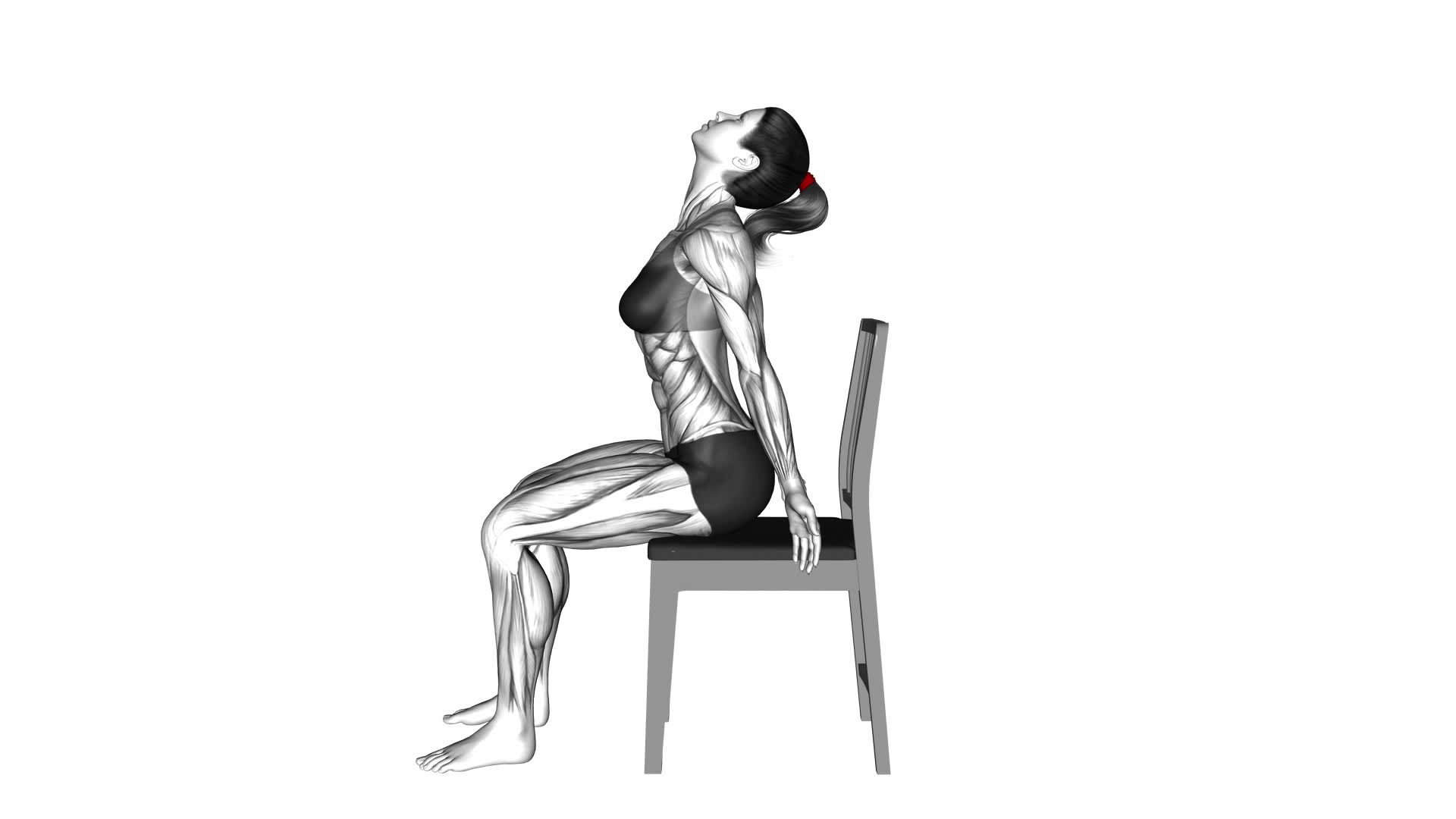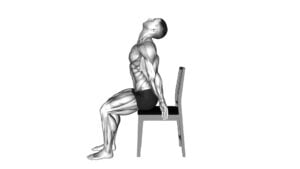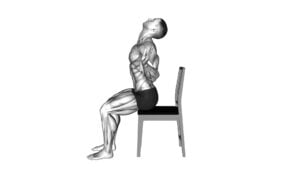Sitting Scapular Adduction (female) – Video Exercise Guide & Tips

Are you looking to strengthen your scapular muscles and improve your posture?
Watch This Exercise Video
In this video exercise guide, we'll show you how to perform sitting scapular adduction.
This exercise targets the muscles between your shoulder blades and can be done right from the comfort of your own home.
By following our proper form and technique tips, you'll be on your way to a stronger upper back in no time.
So grab a chair and let's get started!
Key Takeaways
- Improved posture
- Reduced risk of shoulder injuries
- Targets muscles in the upper back and shoulders
- Strengthens muscles that retract and stabilize the scapulae
Benefits of Sitting Scapular Adduction
The benefits of sitting scapular adduction include improved posture and reduced risk of shoulder injuries. Sitting scapular adduction is an exercise that targets the muscles in the upper back and shoulders, specifically the muscles that retract and stabilize the scapulae. By performing this exercise with proper technique, you can strengthen these muscles, which in turn leads to improved posture. When the scapulae are properly aligned and stabilized, it helps to maintain a neutral spine position, preventing slouching and rounding of the shoulders.
In addition to improved posture, sitting scapular adduction also helps reduce the risk of shoulder injuries. The exercise targets the muscles that support the shoulder joint, such as the rhomboids, trapezius, and serratus anterior. Strengthening these muscles helps to stabilize the shoulder joint, making it less susceptible to injuries caused by overuse or improper movement patterns.
To maximize the benefits of sitting scapular adduction, it's important to avoid common mistakes. One common mistake is shrugging the shoulders during the exercise. Instead, focus on keeping the shoulders relaxed and down, allowing the scapulae to retract and stabilize naturally. Another mistake to avoid is using excessive weight or resistance, as this can lead to strain or injury. Start with lighter weights or resistance bands and gradually increase as your strength and technique improve.
Proper Form and Technique
To perform the sitting scapular adduction exercise with proper form and technique, you need to focus on maintaining a relaxed and stable shoulder position while retracting and stabilizing the scapulae. Start by sitting upright on a chair with your feet flat on the ground and your knees bent at a 90-degree angle. Place your hands on your thighs, palms facing down. Keep your shoulders relaxed and down, away from your ears.
To begin the exercise, squeeze your shoulder blades together, as if you're trying to hold a pencil between them. Hold this position for a count of two, then relax your shoulder blades back to the starting position. Repeat this movement for the desired number of repetitions.
It is important to maintain proper form throughout the exercise. Avoid rounding your shoulders or hunching forward. Keep your back straight and your chest lifted. Common mistakes include shrugging the shoulders, using excessive force, or allowing the neck to tense up. Remember to breathe deeply and maintain a steady rhythm throughout the exercise.
Transitioning into the subsequent section about equipment needed for the exercise, the sitting scapular adduction can be performed without any equipment, making it a convenient exercise that can be done anywhere.
Equipment Needed for the Exercise
Before you begin the sitting scapular adduction exercise, it's important to have the right equipment.
The essential equipment for this exercise includes:
- A sturdy chair or bench
- A resistance band
If you don't have a resistance band, you can use alternatives such as:
- Dumbbells
- Water bottles filled with sand or water to add resistance to the exercise.
Essential Equipment for Exercise
You'll need a chair with armrests to properly perform the Sitting Scapular Adduction exercise. This exercise is great for targeting and strengthening the muscles in your upper back and shoulders.
To enhance your exercise routine, here are some essential equipment options that you can consider:
- Resistance bands: These versatile and affordable bands can be easily incorporated into your routine to add resistance and increase the intensity of your exercises.
- Dumbbells: Adding dumbbells to your exercises can help build strength and muscle tone. They come in various weights, making it easy to choose the right level of resistance for your needs.
- Exercise ball: Using an exercise ball can help improve stability and balance while performing exercises. It can also engage your core muscles, providing an added challenge.
- Yoga mat: A comfortable and non-slip yoga mat can provide cushioning and support during floor exercises, making them more enjoyable and effective.
Alternatives to Expensive Equipment
If you don't have access to expensive equipment, try using household items as alternatives for the Sitting Scapular Adduction exercise.
There are affordable options and DIY alternatives that can help you achieve the same results without breaking the bank.
One option is to use resistance bands, which are inexpensive and can provide the necessary resistance for the exercise. Simply anchor one end of the band to a sturdy object and hold the other end in your hand as you perform the scapular adduction movement.
Another option is to use water bottles or cans as makeshift weights. Fill them with water or sand to add some resistance to your exercise.
Remember to always prioritize safety and proper form when using household items as exercise equipment.
Common Mistakes to Avoid
When performing the sitting scapular adduction exercise, it's important to be aware of common mistakes that can lead to incorrect form and potential dangers.
One common mistake to avoid is rounding your shoulders forward instead of retracting them, as this can strain the muscles and joints.
Another mistake is overexertion, where you push yourself too hard and risk injury.
Incorrect Form Dangers
To avoid potential dangers and maximize the effectiveness of the sitting scapular adduction exercise, it's important that you maintain proper form. Incorrect form risks can lead to overexertion dangers and increase the likelihood of injury. Here are some common mistakes to avoid when performing this exercise:
- Allowing your shoulders to slump forward: This places unnecessary strain on the neck and upper back, increasing the risk of muscle imbalances and discomfort.
- Using excessive weight: Trying to lift too much weight can lead to muscle strains or tears, especially in the shoulders and upper back.
- Failing to engage the core: Neglecting to activate your core muscles can result in poor posture and decreased stability during the exercise.
- Rushing through the movement: Performing the exercise too quickly can compromise form and reduce the effectiveness of the exercise.
Overexertion Risks
To prevent overexertion and minimize the risk of injury, it's crucial to avoid these common mistakes when performing the sitting scapular adduction exercise.
One common mistake is using too much weight or resistance, which puts excessive strain on your muscles and joints. It's important to start with a manageable weight and gradually increase it as your strength improves.
Another mistake is using improper form, such as rounding your shoulders or arching your back. This can lead to imbalances and overuse injuries. Ensure that you maintain proper posture and engage the correct muscles throughout the exercise.
Lastly, avoid rushing through the exercise and sacrificing proper technique for speed. Take your time and focus on performing each repetition correctly to reduce the risk of overexertion and injury.
Variations to Challenge Yourself
To challenge yourself and further enhance your scapular adduction, try incorporating these variations into your sitting routine:
- Resistance Bands: Attach a resistance band to a stable object and hold the other end in your hand while performing the exercise. This will add resistance and increase the difficulty of the movement.
- Dumbbell Raises: Hold a dumbbell in each hand and perform scapular adduction while seated. The added weight will provide an extra challenge for your muscles.
- Unilateral Adduction: Instead of performing the exercise with both arms simultaneously, try doing it one arm at a time. This will require more stability and control, as well as engage your muscles in a different way.
- Isometric Holds: Hold the scapular adduction position for a longer duration, gradually increasing the time as you progress. This will improve your endurance and strengthen your muscles.
By incorporating these variations into your sitting routine, you can continue to challenge yourself and make progress in your scapular adduction exercises. These variations add variety to your workout, target different muscle groups, and help prevent plateaus.
Now, let's move on to some tips for incorporating sitting scapular adduction into your workout routine.
Tips for Incorporating Sitting Scapular Adduction Into Your Workout Routine
To continue challenging yourself and incorporating sitting scapular adduction into your workout routine, here are some tips for maximizing your efforts.
This exercise targets the muscles in your upper back, specifically the rhomboids and middle trapezius. By strengthening these muscles, you can improve your posture, reduce the risk of shoulder injuries, and enhance your overall upper body strength.
One tip for incorporating sitting scapular adduction into your routine is to start with lighter weights and gradually increase the resistance as you become more comfortable and confident with the movement. This will allow you to focus on your form and ensure that you're performing the exercise correctly.
Another tip is to perform this exercise with controlled and deliberate movements. Avoid using momentum or jerking motions, as this can lead to improper form and potential injury. Instead, focus on squeezing your shoulder blades together as you bring the weights towards your body.
Additionally, it's important to maintain a neutral spine throughout the exercise. Avoid slouching or arching your back, as this can put unnecessary strain on your spine and compromise your form.
Incorporating sitting scapular adduction into your workout routine can provide numerous benefits, including improved posture, increased upper body strength, and reduced risk of shoulder injuries. By following these tips and performing the exercise correctly, you can maximize the effectiveness of this exercise and achieve your fitness goals.
Frequently Asked Questions
How Many Sets and Reps Should I Do for Sitting Scapular Adduction?
To improve shoulder strength and reap the benefits of scapular adduction, you should aim for 2-3 sets of 10-15 reps for sitting scapular adduction. This exercise targets the muscles responsible for drawing your shoulder blades together, promoting better posture and stability.
Can Sitting Scapular Adduction Help Improve Posture?
Sitting scapular adduction can be a beneficial exercise for improving posture. By strengthening the muscles in your upper back and shoulders, this exercise helps to pull your shoulder blades back and down, promoting a more upright and aligned posture.
The benefits of sitting scapular adduction include reducing rounded shoulders and upper back pain, improving shoulder stability, and enhancing overall posture. Incorporating this exercise into your routine can contribute to better posture and overall body alignment.
Is It Safe to Perform Sitting Scapular Adduction if I Have a Shoulder Injury?
If you have a shoulder injury, it's important to consider precautions before performing sitting scapular adduction.
This exercise involves the movement of your shoulders, which may aggravate your injury.
It's best to consult with a healthcare professional or a qualified trainer who can assess your specific condition and provide alternative exercises that are safe and effective for your recovery.
Prioritizing your shoulder's healing process is crucial to avoid further damage or complications.
Can Sitting Scapular Adduction Help Alleviate Neck and Shoulder Tension?
Sitting scapular adduction can help alleviate neck and shoulder tension. By performing this exercise, you can improve flexibility and reduce muscle tension in your upper body.
This movement targets the muscles responsible for stabilizing and moving your shoulder blades, which can help relieve stress and tightness in your neck and shoulders.
Incorporating sitting scapular adduction into your exercise routine can be an effective way to address and alleviate discomfort in this area.
How Long Does It Usually Take to See Results From Doing Sitting Scapular Adduction Regularly?
Regularly doing sitting scapular adduction can provide numerous benefits for your neck and shoulder tension. However, the timeline for seeing results can vary from person to person. Some individuals may notice improvements within a few weeks of consistent practice, while others may take longer.
It's important to be patient and stay committed to the exercise. Remember, everyone's progress is unique, and with time and dedication, you can achieve positive changes in your posture and alleviate tension in your neck and shoulders.
Conclusion
Incorporating sitting scapular adduction into your workout routine can provide numerous benefits. This exercise can improve your posture, increase upper back strength, and enhance shoulder stability.
To maximize the effectiveness of this exercise, it is important to maintain proper form and technique. Use the necessary equipment, such as a resistance band or weights, to add resistance to the movement.
Avoid common mistakes, such as rounding your shoulders or using excessive momentum. Focus on engaging the muscles in your upper back and shoulder blades throughout the exercise.
Furthermore, challenging yourself with variations of the sitting scapular adduction exercise can further enhance your progress. This can include using different grips or adjusting the angle of your body.
By incorporating sitting scapular adduction into your routine and following these tips, you can enjoy the benefits it brings to your overall fitness.

Author
Years ago, the spark of my life’s passion ignited in my mind the moment I stepped into the local gym for the first time. The inaugural bead of perspiration, the initial endeavor, the very first surge of endorphins, and a sense of pride that washed over me post-workout marked the beginning of my deep-seated interest in strength sports, fitness, and sports nutrition. This very curiosity blossomed rapidly into a profound fascination, propelling me to earn a Master’s degree in Physical Education from the Academy of Physical Education in Krakow, followed by a Sports Manager diploma from the Jagiellonian University. My journey of growth led me to gain more specialized qualifications, such as being a certified personal trainer with a focus on sports dietetics, a lifeguard, and an instructor for wellness and corrective gymnastics. Theoretical knowledge paired seamlessly with practical experience, reinforcing my belief that the transformation of individuals under my guidance was also a reflection of my personal growth. This belief holds true even today. Each day, I strive to push the boundaries and explore new realms. These realms gently elevate me to greater heights. The unique combination of passion for my field and the continuous quest for growth fuels my drive to break new ground.







